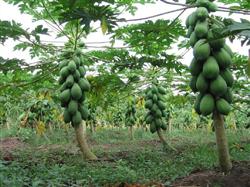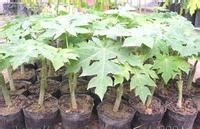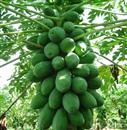Standardized high-yield cultivation techniques of papaya

Papaya fruit oval, pulp lignified, resistant to storage, natural storage can be up to 5-6 months. The skin is smooth, waxy, golden and shiny; clean and beautiful, rich and unique aroma, placed indoors, aroma overflowing, lasting for a long time. Because there is a layer of mucous membrane on the surface of Yizhou papaya seeds, the seedling emergence rate is low, the planting area is small, and the yield per unit area is not high, so it is difficult to meet the market demand. For this reason, the standardized high-yield cultivation experiment of Yizhou papaya was carried out from 1998 to 2004, and good results were obtained. The test results are summarized as follows. 1 the basic situation of the experimental site is located in the Science and Technology demonstration Park of Agriculture and Forestry College of Linyi normal University. The annual average temperature is 13.2℃. The average temperature in January is-2.6℃, the average temperature in July is 27.6℃, the effective accumulated temperature is 4417 ℃, the average annual sunshine hours is 2417 hours, the frost-free period is 202days, and the average annual precipitation is 869mm. The experimental site is sandy loam, the soil layer is deep, pH6.9, the content of soil organic matter is 0.9%, and the condition of drainage and irrigation is good. (2) Seedling culture 2.1 seed collection the fully ripe fruits were collected from the mother trees with strong growth and strong stress resistance, and the early fruits were stacked in a cool place before ripening. In the middle and late November, cut the fruit longitudinally with a knife and peel out the seeds. Soak the seeds in 0.3% neutral laundry powder for 2 hours, scrub constantly, wash the mucus on the seed surface, then soak in water for 3 hours, then filter out the water, then soak in water for 3 hours, and then wash the washing powder on the seed surface. 2.2 seed stratification treatment, mix the washed seeds with clean wet sand according to 1 ∶ 5, and the humidity of sand should be held by hand without dripping, hands loosened and sand mass cracked. Seeds can be placed in the 50cm deep ditch layer, can also be put into a large flowerpot, and then half buried in the pot, the pot mouth slightly higher than the ground, too wet to dry in time, pay attention to rodent prevention. The processing time of stratification should not be less than 30 days. 2.3 soil preparation and sowing 2.3.1 Sandy soil with irrigation conditions is better for nursery land. Before sowing, 334 cubic meters of rotten high-quality soil fertilizer, 25kg, 3% phoxim granule 2~3kg, 40% carbendazim 0.5~1kg were applied, and the soil was leveled by turning 20~30cm deeply after sowing. Make the border according to the width of 1.2m and the length of 30m to 40m, leaving a good drainage and irrigation channel. 2.3.2 sowing papaya can be sown in spring and autumn. Autumn sowing is carried out before land freezing (mid-November, late November), which can reduce the germination time of sand storage, and the general seed consumption per mu is 1~1.5kg. Spring sowing is carried out after thawing in early spring (early March). The seeds are first put in a warm place to promote germination. The radicles of the seeds are sown when the radicles are white, and the amount of seeds per mu is 1kg. It is better to sow with strip sowing, 4 rows per row, big row 40cm, small row 20cm; open the ditch of 2cm, water along the ditch, wait for the water to seep, spread the seeds evenly into the ditch, cover the soil about 2cm, and slightly suppress and cover the plastic film the next day. 2.3.3 in mid and late February, according to the proportion of soil, sand and soil miscellaneous fertilizer 5 ∶ 3 ∶ 2, diammonium phosphate 1kg, ferrous sulfate 100g, zinc sulfate 50g, 40% carbendazim 150g, 25% trichlorfon 60g per cubic meter of soil were added, mixed with a small amount of insecticide and fungicide, packed into a seedling bowl with a diameter of 8.8cm, discharged into the border bed, watered thoroughly, and the germinating seeds hidden in sand were placed in the bowl. Cover fine sand or loose soil and set up an arch shed on the border surface. The grass curtain with thick 2cm was covered in the early night. When the temperature in the shed exceeded 25 ℃ in the middle and late March, it was ventilated in time, and the seedlings were released in early April. In the middle of April, get rid of the seedling bowl and water the seedlings in time after transplanting with soil. this method can slow the seedlings and grow healthily, and the seedlings can be grafted in the same year. 2.4 after the nursery management seedlings are unearthed, check the nursery every evening, break the membrane and release the seedlings in time, and water them in time when the weather is dry. When the seedling height is about 20cm, combine watering, apply urea 10kg per mu. Fertilize outside the root once every 7-10 days, and 0.3% urea and multi-element micro-fertilizer should be used alternately. Grafting can be carried out when the seedling height is about 50cm and the ground diameter is above 0.5cm. 2.5 Seedling grafting 2.5.1 scions were selected to cut new shoots with full bud eyes or one-year-old branches from excellent varieties free of diseases and insect pests. When grafting in the growing season, the new shoots should be cut off with the removal of leaves, and the petiole with 0.3~0.5cm length should be retained. It is best to use it with cutting, or wrap it in a wet cloth and put it into the well near the surface of the water for temporary storage. 2.5.2 grafting method ① "T" shape bud grafting can be carried out from the middle of May to the end of September. This method is simple, easy to master, fast and high survival rate. The key point is that when cutting the rootstock, do not cut the xylem, and the upper end of the bud is flush with the cross-cutting. ② splicing is mostly used in spring, and it can also be used on rootstocks with vigorous growth in summer. The advantage of split grafting is that the seedlings are grafted in the same year. In order to improve the survival rate, it is necessary to master the grafting principle of "flat, neat, strict, white on the top and empty on the bottom". That is to say, the cutting surface of the scion should be smooth, the phloem can not be split, the cambium of the rootstock should be aligned when inserted into the scion, the top of the wedge-shaped cutting surface of the scion should expose 3mm or so, and there should be a little gap in the lower part of the scion. 3 High-yielding cultivation techniques 3.1 in the autumn of the year before the establishment of the garden, the land was leveled, the planting holes of 1 m square were dug according to the plant and row spacing, and the topsoil and core soil were stacked respectively. In the following spring, each hole was filled with 12kg crop straw and core soil, then mixed with topsoil and farm manure (15~20kg per hole), and then filled with water. Select 2-3-year-old papaya root tiller seedlings with plant height above 110cm and ground diameter above 0.7cm, dig as many whisker roots as possible, and cut off the damaged part of the root system. The roots of seedlings were soaked in clean water for 12 hours and then planted. According to the north-south direction, the planting row and plant spacing is 3 × 2m, the main variety is "Changjun", the pollination variety is "Hongxia", and the proportion is 4 ∶ 1. When planting, dig the 30cm square hole in the middle of the backfilled hole, apply 250g potassium sulfate compound fertilizer mixed with the soil, then plant the seedlings and irrigate after planting. One to two years after planting, peanuts, soybeans and other crops can be intercropped between rows, and tree plates can be cleared. 3.2 Fertilizer and water management began in late May of that year, combined with irrigation and topdressing for 3 or 4 times, and each plant was treated with urea 0.15kg or ammonium bicarbonate 0.15kg. From the second year after planting, base fertilizer is applied every autumn. Under the canopy projection line, the fertilizer application ditch was dug 1m in length and 0.4m in width and depth. Farm fertilizer 20~25kg and potassium sulfate 0.5kg were applied to the plant, and base fertilizer was applied alternately between plants and rows. Topdressing twice in the growing season: the first time in the vigorous growth period of spring shoots (when the new shoots grew 20cm), the plants were applied urea 0.25kg and potassium sulfate 0.3 kg, and the second time in the fruit expansion period in the middle of June, urea 0.5kg and potassium sulfate 0.4kg were applied. Water was irrigated once before sprouting, for a long time of shoot speed and before winter. Control water during flowering. After shaping and pruning, the tree height is 2.1cm / 2.3m, crown diameter 1.2m / 1.5m, trunk height 0.5m / 0.6m. There are 10-12 staggered main branches on the middle trunk, 20~25cm distance between adjacent main branches, and 3 fruiting branches groups on each main branch. In the planting year, the stem was fixed at the 80~100cm above the ground, and in the growing season, the central trunk and 4 main branches were selected in the shaping band (30~40cm under the cut), and all the branches below the shaping band were removed. In the winter of the second year, 50~70cm was truncated in the central stem, and 3-4 main branches were selected in the appropriate position, and 2-3 main branches were selected in the winter of the third year, and medium and small fruiting branches were cultured on the main branches selected in the previous 2 years. After the fourth year, continue to cultivate a good result skeleton. Slow release of main branches, promote the growth of medium and short branches, cut off dense branches, weak branches and disease and insect branches and so on. 3.4.Flower and fruit management should be carried out artificial pollination in case of overcast and rainy weather, and pollinated on the blooming style with a brush dipped in pollen, or sprayed with 10kg water, 0.5kg sugar, 30g urea, 20g pollen and 10g borax, once in the early flowering stage and once in full bloom. Fruit thinning in time within 30 days after flowering. The large fruit spacing is about 25cm, the small fruit spacing is about 20cm, the upper part and periphery are more, the lower part and inner chamber are less. The reasonable load of trees in full fruit stage is 3500~4000kg per mu. Prop up the drooping main branch with a stick or bamboo pole to prevent the fruit from breaking the main branch. 3.5 the main diseases and insect pests of local wrinkled papaya include papaya leaf spot, ring rot, dry rot, aphids, papaya borer, pear planthopper and so on. Control method: in the first ten days of March (before sprouting), 3-5 Baumedu stone sulfur mixture was sprayed to reduce the source of overwintering diseases and insect pests. When there are aphids in late April, spray 3000 times of imidacloprid EC. From late May to early June and early July, 30% Peach Xiaoling EC 1500 times and 50% carbendazim wettable powder 600 times 800 times mixture were sprayed once to control papaya borer and leaf spot. From mid-July to before defoliation, 50% carbendazim wettable powder 600 × 800 times, 1 ∶ 1 ∶ 200 Bordeaux and other fungicides were sprayed alternately for a total of 2 times. At the same time, attention should be paid to the control of various pests such as caterpillars, pear planthoppers and stinging moths. After the beginning of winter, clean up the orchard, sweep away fallen leaves, stiff fruits and disease and insect branches, concentrate on destruction, and reduce the source of overwintering diseases and insect pests.
- Prev

How to select papaya seedlings
To grow papaya, you have to choose good seedlings first. Look, these melons are growing well, but there are a lot of tips when choosing seedlings at the beginning. Reporter: Hello, dear viewers, there are two papayas beside me. One tree bears long melons and the other bears round melons. Both melons grow well. But to say which one is better.
- Next

Cultivation techniques of Chaenomeles sinensis
Wild papaya is a deciduous shrub or small tree of Rosaceae, also known as Tiejiao pear, papaya, etc. Enjoying the laudatory name of "fruit of hundred benefits", it can produce more than 200 varieties of beverages, foods, health care products, medicines, cosmetics, beverages and pigments in eight categories. In recent years, Guizhou Province gradually strengthen industrial restructuring, vigorously develop "green...
Related
- Moge, come on! The staff of the peasant association in the producing area of cantaloupe were frightened when the crowd gathered.
- Causes and Solutions of low Fruit setting rate of Apple
- Symptoms and control measures of passion fruit virus disease
- Fruit growing lesson: how do apple orchards keep high yields?
- Can you build orchards in the mountains? What are the pros and cons?
- How to manage the coloring period of Crisson grape?
- This paper introduces the processing technology of two kinds of fig products.
- How much is a month for retired teachers in rural areas by 2020?
- How can strawberry planting increase sugar content? We should pay attention to management in many aspects.
- What are the cultivation techniques on how to improve the yield of golden fruit?

